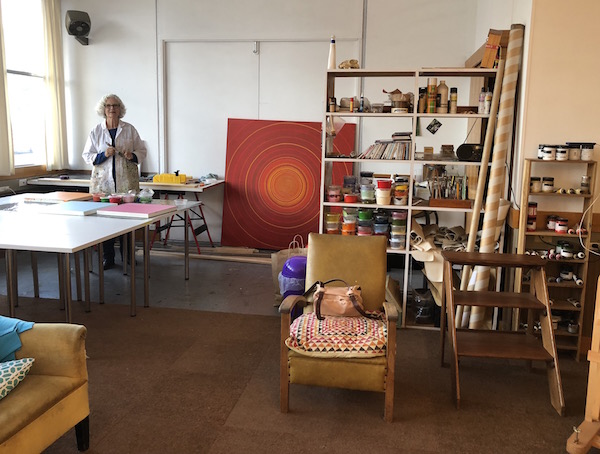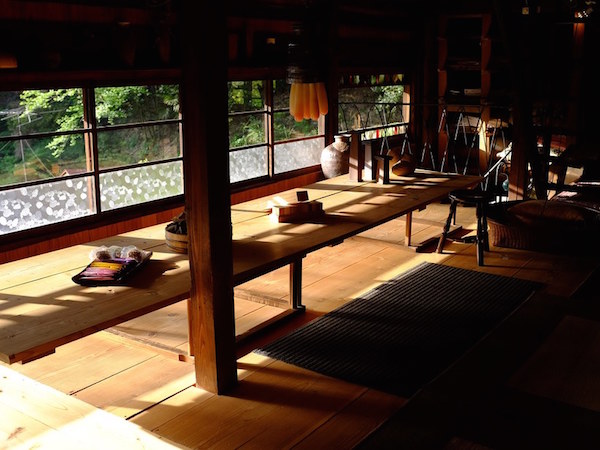Featured image is a detail from “Sashiko 3” by Faridah Cameron. (Please note, these tiny images can only give a suggestion of Faridah’s large and intricate paintings. Readers are encouraged to seek them out at exhibitions and through Handmark Gallery, Hobart.)
Art’s Mysterious Alchemy
What do we mean when we talk about artistic sensibility? Maybe we refer to a heightened sensitivity to one’s surroundings, an ability to notice small (and large) things which others miss, to consolidate them, re-work them, and draw meaning. Of course to some extent we all do that, every day. This is how character and world view are formed. This is what it is to be alive.
But for an artist, the stuff of life is something else. All these multiple, diverse elements — sights, sounds, thoughts, ideas, emotions, stories, dreams — are consolidated, rubbed together, and distilled into something new.

“For me the role of the arts is to nourish and replenish, to sustain our inner life and to affirm our ability to respond in a sentient way to what we observe around us. Through the arts, we colour our existence.” February 2015
For Hobart’s Faridah Cameron it appears that almost nothing has gone to waste. From the needlework she learned as a young child, to formative years spent painting towering paper lanterns, and the music she listens to while she paints … and time spent in Japan, and her experience as a funeral celebrant … even her “sometimes rather whacky” education at a school run by Anglican nuns … Faridah has absorbed myriad influences, experiences, attitudes and ideas. During our conversation in the Afterword Café at Fullers, she spoke to me of her “inner library” of images and processes, which she draws on to inspire and enrich her extraordinary body of painting. (Below, unattributed quotations come from that conversation.)

“My underlying concerns are to do with the cultural translation of the physical existence; of our ideas of who we are and how we relate, societally, culturally and within the biosphere.” Faridah Cameron, May 2014

The Biennale of Australian Art 2018
This year Faridah has been invited to present at the first Biennale of Australian Art, which begins on 21st September in Ballarat. The paintings she is producing for this ground-breaking event consolidate many elements of her previous work, and take them in a new direction.
“Thread for me is a metaphor, for joining and making and repairing. I like my canvasses to be meeting grounds for things that are usually kept quite separate.” Faridah can be seen talking about her work on a video made for the Biennale.

As often happens in Faridah’s process, she began painting for the Biennale with a strong but unformed idea, this time about music. She found that the painting “didn’t turn out” as she had expected. But when she stood back and looked at it, she was aware of a suggestion of musical notation, and this drove her into an exciting collaboration with the University of Tasmania’s Conservatorium of Music. Students will compose pieces in response to the works and these will be played during the exhibition.
These new works will be rich and multi-layered and the secrets to understanding them lie in Faridah’s life and the themes which have arisen repeatedly in her art.
The Integrity of Being
In a blog post from 2015, Faridah explains that her paintings start from memories. She describes a childhood during an era where fabric scraps were kept and garments were patched, and compares her mind to a “ragbag” of old materials.
Don’t be fooled. When it comes to her art, Faridah’s ideas are polished and ordered. In conversation she is philosophical and erudite, speaking eloquently about her work and the experiences that lie behind it.
Her motivations are profound.
“I believe that artists must work with the integrity of being … Perplexity is both the ancestor and the descendant of enlightenment. In the sense that art seeks understanding through sometimes irrational means, in today’s society art is the inheritor of the sacred.” May 2014

Education, re-examined
As a young girl, Faridah was educated at St Michael’s Anglican School in Melbourne. Early religious instruction, carefully re-examined and “filtered”, together with her experiences with other cultures and recent work as a marriage and funeral celebrant, have left Faridah aware of the importance of ritual and the meditative nature of repetition.
“The religious teaching gave me an insight into a lot of the things that happen in our society, the way we do things. So in retrospect it was very valuable … But I did have to sift it and discard. It took me a long time to get to a point of understanding.”
“Even if there isn’t deep meaning, one still has to live as if there was.”
Despite her interest in biological forms and physical principles, which continues to this day and is evident in many of her paintings, the young Faridah found she was completely unsuited to scientific endeavour. In a radiotherapy course, she realised she was going home and drawing her patients.
“I thought this is silly. This is not what I should be doing.”

A Degree in Fine Art
But if Faridah’s true vocation was art, she did not recognise this until years later, after she was married with five children and living in Darwin.
“Raising children gives you a second go at being creative. In encouraging your children’s creativity you can reconnect with your own childhood.”
The original idea was to study graphic arts in order to participate in her first husband’s work in advertising. The only course available was at the then Darwin Technical College. When this became a university, Faridah graduated with a BA in Fine Art.
“Art school was confronting. I loved it. But … I always had this feeling that there was something I wanted to do but for me, art school wasn’t actually the place to find it.”
The Real Learning
It was after completing her degree that Faridah embarked on what was possibly one of her most productive learning experiences. From 1993 to 2002, she worked with Neil Cameron in a visual theatre company.

Faridah became artistic director and principal artist for dozens of events across Australia, gathering local artists in different communities to develop a large-scale, non-narrative form of theatre.
“I just discovered I could really do it … I realised this was something that made a lot more sense to me than making etchings and putting things in a gallery for half a dozen people to see.”
For thirteen years, Faridah’s imagery formed the centrepiece of the Fire Event at Woodford Folk Festival, a New Year’s ritual attended by thousands.
“I built images ranging from tiny shadow puppets to towering, highly decorated structures that were ignited in climactic bonfires. I also guided others … working with indigenous communities and among people who identified with many different cultures from around the world. It is hard to imagine a richer learning environment for the study of culture and the practice of art.” May 2014

The work gave Faridah invaluable experience with materials and techniques and the language of sign and symbol.
“You’re thinking about light. I was often painting on the surfaces of lanterns. So you learn a great deal about pigments and transparency and opacity and the way in which light works in connection with paint and I learned about distance. If you are painting for an audience 16000 people you have to learn what they can see and what they can’t see.”


Experience in festivals also reinforced Faridah’s commitment to the power of ritual.
“Ritual helps with a lot of things. In a societal sense, it helps with associative bonding. It gives people a sense of what they should do and when, and there is reassurance in that. Individually it helps too. Things that are repeated are reassuring.”
After several years, Faridah completed a Masters Degree at QUT and in 2004, she and Cameron moved to Hobart. At this point, Faridah took up full time studio practice.
Japan
In 2015 Faridah found herself in the Japanese village of Fujino, at a ten-day workshop run by Canadian Bryan Whitehead, covering Japanese textiles and indigo dyeing.
“Occasionally it happens that an experience gives everything you had hoped for and more.” June 2015

Japan has had a profound influence on Faridah’s art. Her time there deepened her engagement with the repeated motif, and the colour indigo. Eventually it led to the solo exhibition Tansei at Handmark Gallery in January 2017 .
“Since then the colour indigo has formed the space into which I usually paint. It is the colour of midnight, of deep space or deep water; of infinity, of perfect peace and absolute stasis; the darkness into which the introduction of light comes as a dramatic and moving possibility.” January 2017.

Tansei featured works titled “Sashiko”, which is a form of Japanese running-stitch embroidery. Faridah has also been inspired by Shibori (techniques of dyeing using knots and stitching) and she has developed a fascination with Boro, a Japanese traditional practice of patching and over-stitching to preserve old garments.

“These garments were considered shameful until recent years when private collections began to come to light. The examples of boro that I saw were almost painfully poignant. They revealed poverty, but also great dignity. There was not a stitch or a patch on them that seemed to have been placed carelessly. They demonstrated balance and harmony as well as pathos, and invited close examination and a deepening of understanding. Born of necessity, they had become art.” September 2015.

Cultural Inheritance
The encounter with Japanese thought and techniques resonated with some of Faridah’s other ongoing pre-occupations. She is fascinated by cultural inheritance, “the ways in which ancestral attitudes and beliefs are reflected in our contemporary context” January 2017. Her own inheritance includes very early learning of stitching and needlework.

She is also interested in the forces that operate between people, in pairs and communities.
“Considerations of personal space, of likeness and dissimilarity, of external forces that affect the whole interaction almost imperceptibly at first, then later in easily observable ways.” August 2016
Spiritual
Faridah’s inner life is no ragbag. Her work and her thoughts about her work are profound and deeply spiritual.
“It helps to define the word spiritual, which has been annexed by the religions. But it actually means to do with the life force and if one becomes conscious of one’s inner life, not in a religious sense but in a thinking, feeling sense, then I think that’s a very valuable thing. And I think the creative life has a lot to do with that.”

Faridah is represented by Handmark Gallery.
She has been a finalist in the Alice Prize (Packing Room Prize 2014), Blake Prize (Highly Commended in 2012, 2013), Togart Contemporary Art Prize (2009, 2012), Bay of Fires Art Prize (2012), Glover Prize (2010, 2011, 2013), Archangel Art Prize (2009, 2010), Sovereign Asian Art Prize (2005) and Waterhouse Natural History Art Prize (2005).
In September 2018 she will exhibit at the Biennale of Australian Art in Ballarat.
*All unattributed quotes are taken from a conversation at Fullers Bookshop in February 2018.

Leave a comment